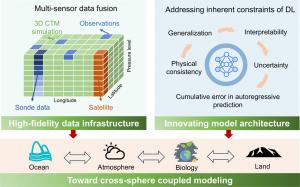Smarter skies ahead: AI reshapes how we predict air pollution
GA, UNITED STATES, October 14, 2025 /EINPresswire.com/ -- Air pollution forecasting is entering a new era powered by deep learning (DL). Beyond traditional physics-based models, DL offers an adaptive, data-driven pathway to decode the atmosphere’s complexity—from fine particulate matter to ozone surges. This review explores how DL can transform air pollutant prediction by fusing satellite imagery, ground monitoring, and meteorological data into near real-time insights. Yet the path forward is not without obstacles: model generalization, interpretability, and uncertainty remain major hurdles. The authors argue that the next breakthrough will come from uniting artificial intelligence with atmospheric science to build forecasting systems that are not only accurate but also explainable and actionable.
Air pollution continues to pose a severe global health and environmental threat, claiming millions of lives each year. Despite progress in chemical transport and climate-chemistry models, their accuracy depends on massive computational resources and often outdated emission inventories. These limitations restrict rapid, high-resolution forecasts needed for early warning and intervention. Meanwhile, the explosion of Earth observation data and advances in artificial intelligence present a new frontier for forecasting the invisible. Deep learning (DL), with its ability to capture complex patterns, offers a way to overcome the constraints of traditional modeling. Based on these challenges, there is an urgent need to develop physically consistent, interpretable, and scalable AI models for air quality prediction.
A research team led by Professor Hongliang Zhang from Fudan University, in collaboration with the University of Manchester, has published ( DOI: 10.1007/s11783-025-2092-6) a review in Frontiers of Environmental Science & Engineering on September 30, 2025. The study offers a panoramic view of how AI is reshaping atmospheric science—highlighting advances in data assimilation, extreme-event forecasting, and physics-informed networks—while charting the next steps toward more reliable, transparent, and actionable pollution forecasting systems for a rapidly changing world.
The review outlines how DL is revolutionizing air quality forecasting by fusing massive, heterogeneous data sources and uncovering patterns invisible to traditional models. Through multi-sensor data assimilation, DL integrates satellite, ground, and meteorological observations to fill data gaps caused by cloud interference or sparse monitoring networks, generating seamless, high-resolution pollution maps. However, current models still falter during extreme pollution events—precisely when accurate forecasts matter most. To address this, researchers highlight transfer learning, ensemble prediction, and synthetic event generation as promising methods to boost model resilience. Equally crucial is the push toward physics-informed neural networks, which embed chemical and physical laws into AI architectures, bridging scientific understanding with computational prediction. The authors also advocate for probabilistic and Bayesian approaches to quantify uncertainty—enabling forecasts that not only predict what will happen but also how confident we can be. Together, these advances signal a paradigm shift from black-box models to interpretable, physically grounded forecasting frameworks that bring science closer to real-world decision-making.
“Our vision is to make air quality forecasting not just smarter but also more trustworthy,” said Professor Hongliang Zhang, the corresponding author. “By blending physics-based reasoning with the power of DL, we can open the black box of AI and make its decisions explainable. This integration allows policymakers and the public to understand why a pollution event may occur and how we can act to prevent it. It’s about turning prediction into prevention—and data into decisions.”
DL is poised to become a cornerstone of intelligent environmental governance. Its ability to deliver real-time, data-driven forecasts can empower governments to issue faster warnings, plan emission reductions, and protect vulnerable populations. The fusion of AI with climate-chemistry models also enables seasonal and long-term predictions critical for anticipating the effects of climate change on air quality. Beyond the science, this approach represents a shift in how society responds to pollution—moving from reactive measures to proactive management. As the researchers conclude, DL could ultimately help create cleaner skies, healthier cities, and a more sustainable planet.
DOI
10.1007/s11783-025-2092-6
Original Source URL
https://doi.org/10.1007/s11783-025-2092-6
Funding Information
This work was supported by the National Natural Science Foundation of China (No. 42377098) and the National Key Research and Development Program of China (No. 2022YFC3701100).
Lucy Wang
BioDesign Research
email us here
Legal Disclaimer:
EIN Presswire provides this news content "as is" without warranty of any kind. We do not accept any responsibility or liability for the accuracy, content, images, videos, licenses, completeness, legality, or reliability of the information contained in this article. If you have any complaints or copyright issues related to this article, kindly contact the author above.

